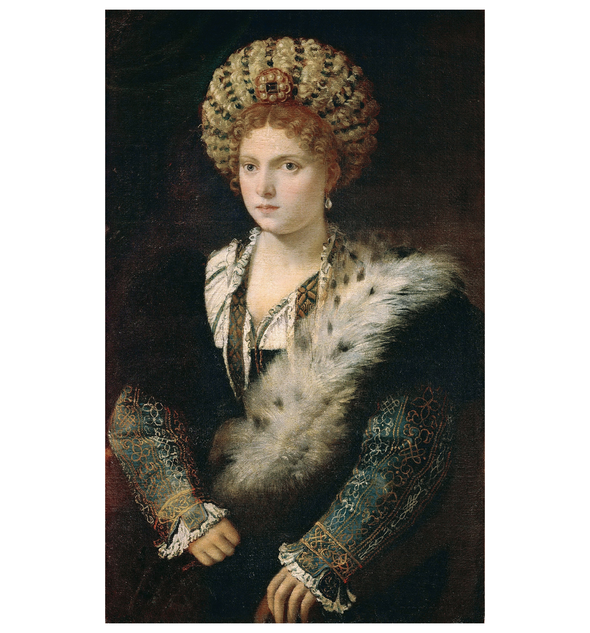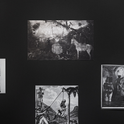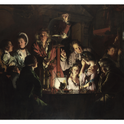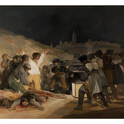It seems to me that I have always known this painting. Once it imprints itself on your retina, how could you forget it? Painted in the early 1530s, it marks the moment when Titian is effortlessly hitting his stride as the greatest portrait painter of his age. Indeed, for the longest time I’m not sure I even knew the name of the sitter. All I saw was a sparkling, self-possessed young woman, eager for life and with the most exquisite dress sense. On a desert island I would have been pushed to choose between her and Leonardo da Vinci’s Lady with an Ermine (circa 1489–1491) as my ideal artistic female companion.
The first time I ever questioned its verisimilitude was when I saw it face to face in the Kunsthistorisches Museum in Vienna and took on board the name of its subject: “Isabella d’Este”. By then I was deep into writing about the Borgia family, and Isabella, Lucrezia Borgia’s last sister-in-law, had already made her mark as a mover and shaker in the art world. A bit of manipulator, she was known for her persistence when it came to getting works for her collection.
But it wasn’t until I turned the spotlight on her alone, as the subject of a novel, that the sheer chutzpah behind this painting came to light. Because here is the first female collector and patron of the Renaissance using art to ensure her own immortality with what we can all agree is a sublime portrait—except for the fact that it looks nothing like her. In itself, of course, that is not such a shock. We know that throughout history male beauty is synonymous with power. (Titian specialised in making even the most ugly men, like Charles V, appear impressive by encasing them in splendid armour.) Women on the other hand needed to look good in themselves. But if I were to tell you that this young woman—what, 18? maybe early twenties?—was actually in her sixties when the portrait was delivered, you would start to appreciate the depth of the deceit.
Actually, in its way, this is a compliment to Isabella. Writing about her, you learn early that she was a law unto herself. Born in the 1470s in the thriving city state of Ferrara and married into the ruling family of the equally artistic state of Mantua, she was clever, well educated, determined and possessed of immense energy and confidence, talents which she used to amass her own collection, including designing and decorating her own studiolo (a chamber for study and artistic contemplation, something that until this moment was only the province of men). On the side, she nurtured a renowned Renaissance court as well as ran the government of Mantua for long periods while her husband, a professional soldier, was away fighting or imprisoned. All this and more emerges from the huge cache of her letters she left, now in Mantua’s dusty state archive, from where her voice sings out, so particular, so sure of herself—she once took the Venetian artist Giovanni Bellini to court for non-delivery of work she had paid for—as to be completely irresistible to the novelist.
Which brings me back to the control of her own portraits. The first one, done when she was young by Mantua’s court painter Andrea Mantegna (never a man prone to flattering his subjects), she furiously dismissed as “bearing no resemblance to us whatsoever” and promptly gave it away. The next one, by Raphael’s father, was damned because “it makes us a little fatter than we are”. It too went the same way. By time she commissioned Titian in the 1530s she was an old woman and spreading in all directions. Clearly this wouldn’t do for posterity. So she sent him an early, exceedingly flattering, image by another painter with express instructions as to exactly what she should be wearing to showcase her trademark influence on fashion. (That splendid headdress is her own design and would go viral in the decades of portraiture to come.) In this way Titian delivered a masterpiece without having to contend with reality, while Isabella got her calling card for the future.
So what did she look like? Well, I might have suggested you check out an earlier portrait that Titian is said to have done a few years before. In the 1520s it seems to have entered the collection of King Charles I—where it was known simply as “Woman in a Red Dress”. But that picture, like the collection, has become lost to history.
But there is an alternative. A few decades after Titian, it seems that another court painter of Mantua, Peter Paul Rubens, had made a copy of it. Like Titian’s later 1530s portrait, that too now hangs in the Kunsthistorisches Museum.
If every picture tells a story, then the journey between these two portraits is the stuff of a whole novel.














